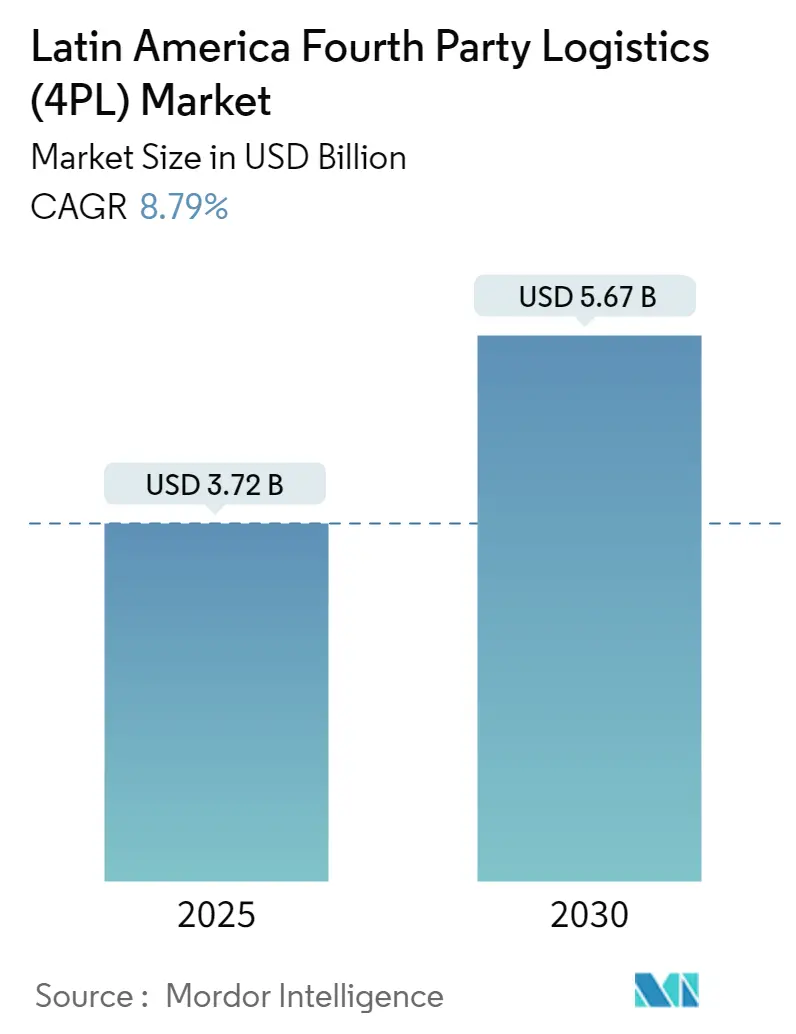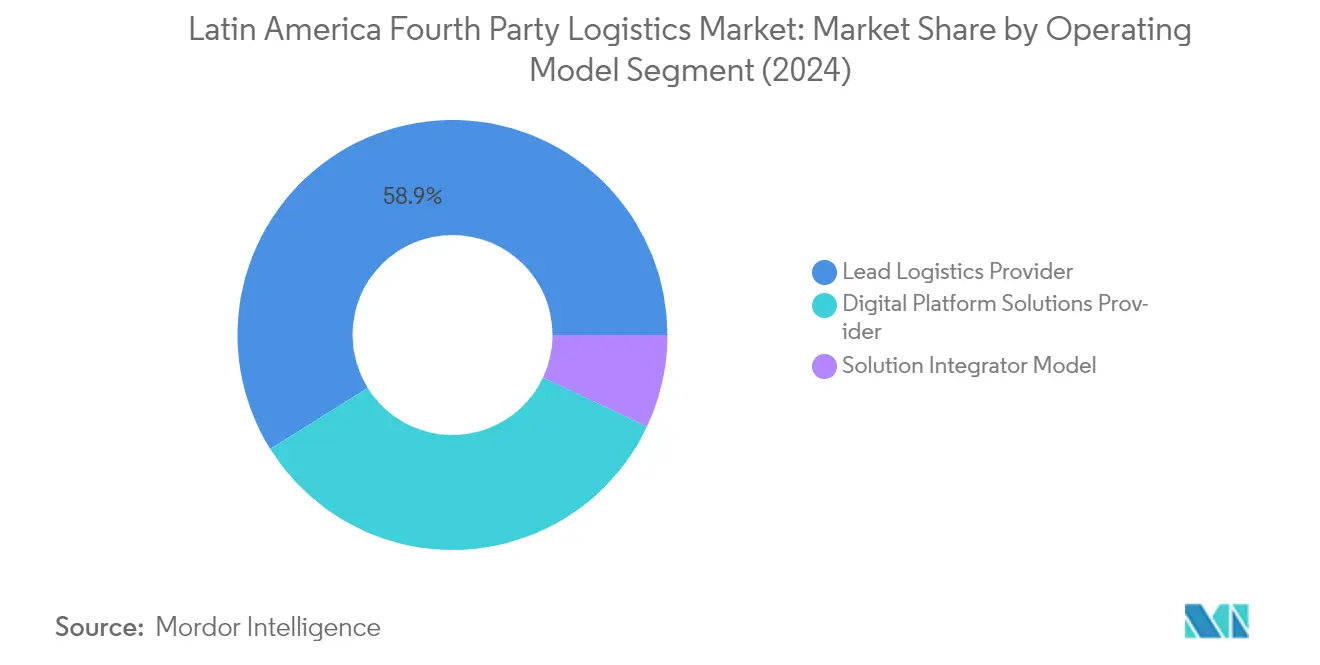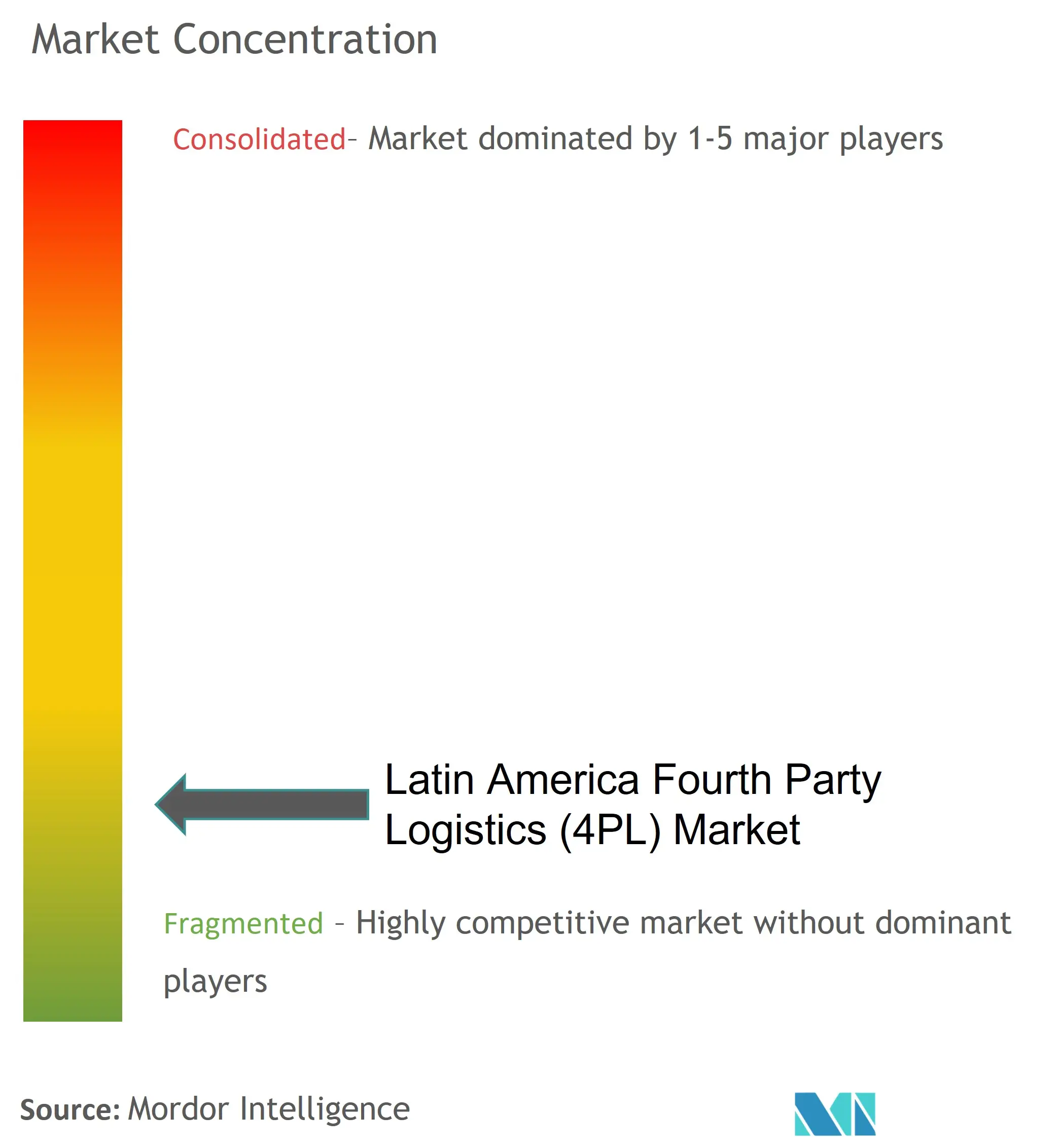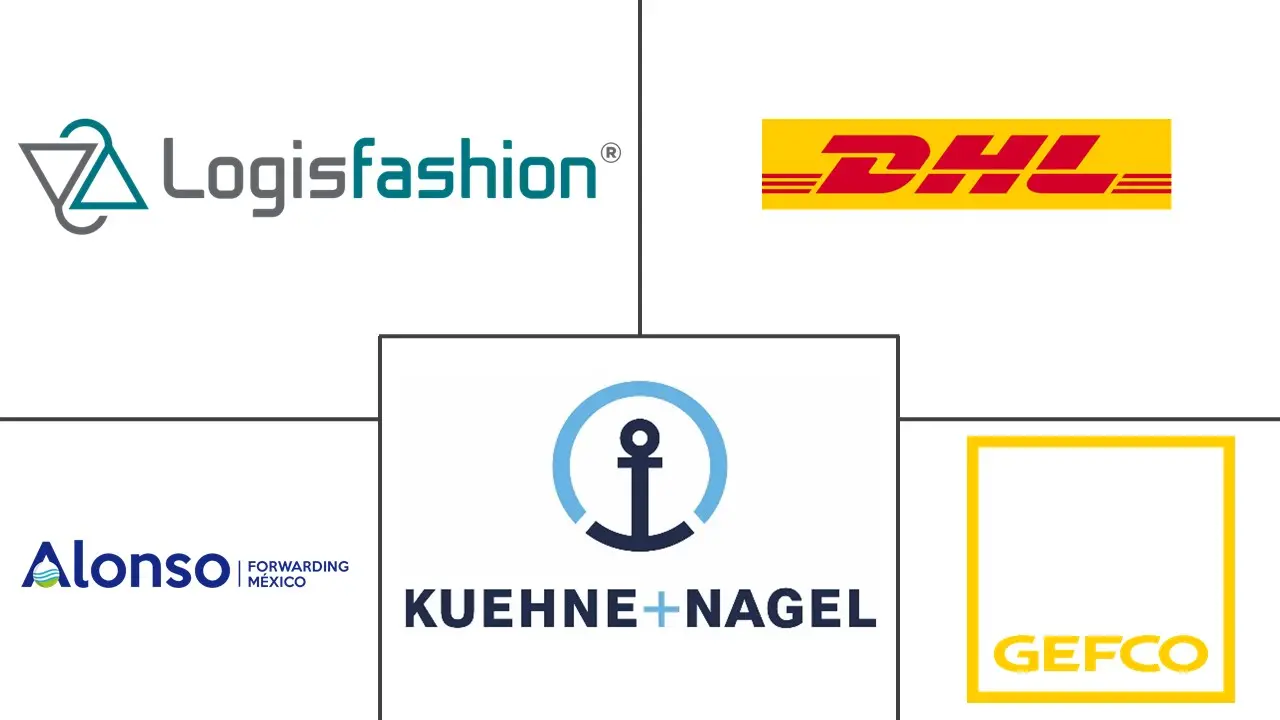Latin America Fourth Party Logistics (4PL) Market Size and Share

Latin America Fourth Party Logistics (4PL) Market Analysis by Mordor Intelligence
The Latin America Fourth Party Logistics Market size is estimated at USD 3.72 billion in 2025, and is expected to reach USD 5.67 billion by 2030, at a CAGR of 8.79% during the forecast period (2025-2030).
The Latin American Fourth Party Logistics landscape is experiencing significant transformation driven by the rise of nearshoring and industrial expansion. Mexico has emerged as a prime example of this trend, with over 530 industrial parks registered in 2022 and approximately 90 more under construction, highlighting the region's growing industrial capacity. This shift is particularly notable as companies from both the United States and China have been establishing manufacturing operations in Latin America, creating new opportunities for 4PL providers to manage increasingly complex supply chains. The trend is further supported by the region's strategic geographical advantages, including access to major consumer markets and established trade corridors.
The digital transformation of logistics operations is revolutionizing supply chain management across Latin America. In 2023, major logistics providers like Maersk demonstrated their commitment to regional growth by expanding their footprint with over 195,000 square meters of warehouses across the region, incorporating advanced digital solutions for inventory management and supply chain visibility. This digital evolution extends beyond traditional logistics, with companies implementing sophisticated control tower systems, blockchain technology, and artificial intelligence to optimize operations and provide real-time tracking capabilities.
E-commerce growth continues to reshape the logistics landscape in Latin America, with the region hosting more than 300 million digital buyers and projecting a 20% growth by 2027. This explosive growth has prompted logistics providers to develop specialized solutions for e-commerce fulfillment, including automated warehousing systems and last-mile delivery optimization. The integration of sustainable practices has become increasingly important, with studies showing that 80% of customers prefer to purchase from companies that demonstrate environmental responsibility through waste recycling and sustainable logistics practices.
The market is witnessing a significant shift toward integrated logistics solutions that combine traditional services with technological innovation. Companies like CEMEX have launched dedicated logistics subsidiaries, such as Alliera, to provide comprehensive Fourth Party Logistics (4PL) services including networking solutions, customs management, and permit facilitation across North America. This trend toward consolidation and service integration reflects the growing demand for end-to-end supply chain solutions that can address the complexities of modern commerce while maintaining efficiency and transparency. The integration of sustainable practices and digital technologies is becoming a standard requirement rather than a competitive advantage, driving innovation across the sector.
Latin America Fourth Party Logistics (4PL) Market Trends and Insights
Growth of E-commerce and Digital Infrastructure
The explosive growth of e-commerce and digital infrastructure across Latin America has become a fundamental driver for fourth-party logistics services. The region's digital landscape has evolved significantly, with over 400 million potential e-commerce consumers across 17 countries as of January 2021, creating an unprecedented demand for sophisticated logistics solutions. This digital transformation is further amplified by the increasing mobile penetration, with projections indicating mobile subscriptions will reach 484 million users by 2025, necessitating more robust and integrated logistics networks to handle the growing volume of online transactions.
The region's unique digital behavior patterns have created specific requirements for logistics operations, with nearly 20% of internet users exclusively focusing on first-page search results and almost half never venturing beyond the top three results. This consumer behavior has led to the emergence of powerful e-commerce platforms like Mercado Libre and Amazon, which require sophisticated 4PL solutions to manage their complex supply chains. The dominance of Android platforms in the region has also influenced how logistics providers develop and implement their technological solutions, requiring specialized approaches to mobile-first logistics management and tracking systems.
Increasing Demand for Supply Chain Optimization
The growing complexity of global supply chains has created an urgent need for sophisticated optimization solutions, driving the adoption of fourth-party logistics services. Modern businesses require comprehensive data integration and analytics capabilities to effectively manage inventory levels, forecast demand, and optimize distribution networks. This need is particularly evident in the implementation of sophisticated data analytics systems that enable logistics teams to make rapid, informed decisions while maintaining operational efficiency and cost-effectiveness throughout the supply chain.
The evolution of supply chain technology has enabled 4PL providers to offer enhanced visibility and control through integrated management systems. These systems incorporate advanced ordering algorithms that consider historical sales data and consumer trends, leading to more accurate inventory management and reduced operational costs. The integration of technology in supply chain management has become particularly crucial as businesses seek to streamline their operations, with 4PL providers leveraging sophisticated data analytics to help distributors and retailers track their inventories with unprecedented precision and make more informed stocking decisions.
Rising End-user Industry Requirements
The diverse and evolving needs of various end-user industries have emerged as a significant driver for the fourth-party logistics market in Latin America. The fast-moving consumer goods (FMCG) sector, in particular, demands constant adaptation to changing consumer preferences and requires precise stock level management through real-time data analysis and decision-making capabilities. This has led to the development of specialized 4PL solutions that can handle the complex requirements of inventory management while ensuring optimal stock levels across multiple distribution channels.
The retail sector's transformation has created additional complexity in supply chain management, requiring the establishment of parallel supply chains to serve both traditional brick-and-mortar stores and online channels effectively. This dual-channel approach has necessitated more sophisticated logistics solutions that can provide strategic vision and enhanced inventory visibility across multiple platforms. The integration of advanced technologies has become crucial for retailers seeking to allocate stock efficiently to meet expanding customer needs while maintaining cost-effectiveness. Furthermore, manufacturers are increasingly relying on lead logistics provider services to manage their complex supply chains, allowing them to focus on product innovation and development while ensuring efficient distribution across multiple channels.
Segment Analysis: By Operating Model
Lead Logistics Provider Segment in Latin America Fourth Party Logistics Market
The Lead Logistics Provider (LLP) segment continues to dominate the Latin America Fourth Party Logistics market, commanding approximately 59% market share in 2024. This significant market position is driven by the increasing trend of manufacturers and retailers outsourcing their logistics operations to specialized providers. LLPs manage and direct all aspects of the entire supply chain, including overseeing transportation management, supervising warehouses, and coordinating various parts of the supply chain. The segment's prominence is further strengthened by its ability to reduce internal costs for companies while providing better management of global supply chains through expertise and value-added services such as supply chain visibility and performance metrics of upstream origin suppliers, carriers, 3PLs, and other players in the supply chain.

Solution Integrator Model Segment in Latin America Fourth Party Logistics Market
The Solution Integrator Model segment is experiencing the fastest growth trajectory in the Latin America Fourth Party Logistics market, with an expected growth rate of approximately 10% during 2024-2029. This rapid growth is attributed to the increasing demand for integrated logistics solutions that can seamlessly connect various aspects of the supply chain. Solution integrators are gaining traction due to their ability to act as the primary integrator of various 3PLs and serve as a single window for freight negotiations, 3PL selection, and freight management on behalf of their clients. The segment's growth is further fueled by the rising adoption of advanced IT solutions, including cloud computing, which helps organizations transform their processes and minimize operational costs.
Remaining Segments in Operating Model
The Digital Platform Solutions Provider segment represents a significant portion of the Latin America 4PL market, offering technology-driven solutions that enhance supply chain efficiency. This segment leverages advanced technologies such as IoT, automation, robotics, and sensors to provide comprehensive supply chain management solutions. Digital platform providers focus on delivering scalable and agile conveying and sorting systems, resulting in greater fulfillment efficiency and accuracy. Their role has become increasingly crucial in modern supply chains that require in-depth, high-quality data about every step in the process, from procurement to final destination.
Segment Analysis: By End User
Retail Segment in Latin America Fourth Party Logistics Market
The retail segment has emerged as a dominant force in the Latin American 4PL market, commanding approximately 28% market share in 2024. This significant market position is driven by the explosive growth of e-commerce across the region, with major retailers increasingly seeking comprehensive supply chain solutions to manage their expanding operations. The segment's strength is particularly evident in countries like Brazil and Mexico, where digital transformation and changing consumer behaviors have led to more sophisticated logistics requirements. Major e-commerce platforms and traditional retailers are leveraging 4PL services to optimize their supply chains, improve inventory management, and enhance last-mile delivery capabilities. The rise of omnichannel retail strategies and the need for seamless integration between online and offline channels has further cemented the retail segment's prominence in the market.
Reefer Segment in Latin America Fourth Party Logistics Market
The reefer segment is experiencing remarkable growth in the Latin American 4PL market, projected to expand at approximately 11% through 2024-2029. This accelerated growth is primarily driven by the increasing demand for temperature-controlled logistics solutions in the pharmaceutical and perishable goods sectors. The segment's expansion is supported by stringent regulations regarding the transportation of temperature-sensitive products, particularly in the healthcare and food industries. The rise in pharmaceutical exports and imports across Latin American countries, coupled with the growing need for cold chain logistics in the agricultural sector, is fueling this segment's rapid development. Additionally, technological advancements in temperature monitoring systems and the integration of IoT solutions in reefer logistics are contributing to the segment's robust growth trajectory.
Remaining Segments in End User Segmentation
The Latin American 4PL market encompasses several other significant segments including FMCG, fashion and lifestyle, and technology sectors. The FMCG segment is characterized by high-volume, low-margin operations requiring efficient supply chain management and quick turnaround times. The fashion and lifestyle segment focuses on seasonal inventory management and rapid response to changing consumer trends, while the technology segment emphasizes secure handling and specialized transportation of electronic components and devices. Each of these segments contributes uniquely to the market's dynamics, with varying requirements for inventory management, distribution networks, and value-added services. The diversity of these segments reflects the adaptability and comprehensive nature of 4PL services in meeting specific industry needs across Latin America.
Latin America Fourth Party Logistics (4PL) Market Geography Segment Analysis
Fourth Party Logistics (4PL) Market in Brazil
Brazil dominates the Latin American 4PL landscape, commanding approximately 40% of the regional market share in 2024. The country's robust manufacturing sector, coupled with its strategic position as a regional trade hub, has fostered an environment conducive to sophisticated fourth party logistics solutions. Brazil's 4PL market benefits from the country's extensive network of over 530 industrial parks, with numerous facilities under construction to meet growing demand. The increasing adoption of digital technologies and automation in supply chain management has particularly strengthened Brazil's position, with companies like CEVA Logistics establishing regional centers of excellence. The country's e-commerce boom has further catalyzed the need for integrated logistics solutions, with major players expanding their warehousing and fulfillment capabilities. Brazil's 4PL sector is particularly strong in the automotive, retail, and consumer goods segments, supported by advanced technological infrastructure and a growing emphasis on sustainable logistics practices.
Fourth Party Logistics (4PL) Market in Mexico
Mexico's 4PL market has emerged as a crucial logistics hub, benefiting significantly from the nearshoring trend and its strategic position as a gateway between North and South America. The country's unique geographical advantage, with access to two oceans and proximity to the United States, has attracted numerous international companies seeking to optimize their supply chain operations. Mexico's logistics landscape is undergoing rapid transformation, particularly in regions like Celaya, which has become a major logistics hotspot due to its strategic crossroads location. The country's manufacturing installed capacity is expanding rapidly across various sectors, including automotive, aerospace, industrial machinery, medical devices, and emerging industries like toys, textiles, and semiconductors. Mexico's commitment to logistics infrastructure development is evident in its investment in intermodal ports and specialized logistics parks, creating an ecosystem that supports sophisticated fourth party logistics market operations. The country's high ratio of engineering graduates within the OECD and its network of free trade agreements with 50 different countries further strengthen its position in the 4PL market.
Fourth Party Logistics (4PL) Market in Colombia
Colombia's 4PL market has established itself as a vital component of the Latin American logistics landscape, leveraging its strategic position with five major commercial hubs, including Bogota, Medellin, Cali, Barranquilla, and Cartagena. The country's logistics sector is experiencing significant transformation, particularly in its cold chain capabilities and agricultural logistics services. Colombia's position as the world's second-largest exporter of flowers has created specialized logistics requirements, driving innovation in temperature-controlled supply chain solutions. The country's commitment to digital transformation in logistics operations has attracted major international 4PL providers, who are establishing sophisticated control towers and implementing advanced tracking systems. Colombia's growing focus on sustainable logistics practices and its strong trade relationships with neighboring countries have created new opportunities for 4PL providers to optimize cross-border operations and implement innovative supply chain solutions.
Fourth Party Logistics (4PL) Market in Chile
Chile's 4PL market distinguishes itself through its robust international trade infrastructure and strong economic stability. The country's position as a regional leader in market-oriented policies has attracted significant investment in logistics infrastructure, particularly in warehouse operations and distribution centers. Major logistics providers are expanding their presence across Chile, establishing state-of-the-art facilities equipped with advanced technology solutions. The country's commitment to environmental sustainability in logistics operations has driven innovation in green supply chain practices. Chile's strong trade relationships with Asia-Pacific economies and its participation in multiple trade agreements have created complex supply chain requirements that 4PL providers are uniquely positioned to address. The country's focus on digitalization and automation in logistics operations has led to the implementation of sophisticated warehouse management systems and real-time tracking solutions, enhancing the overall efficiency of supply chain operations.
Fourth Party Logistics (4PL) Market in Other Countries
The remaining Latin American countries, including Argentina, Peru, Bolivia, Venezuela, and others, collectively represent a diverse and evolving 4PL market landscape. These markets are characterized by varying levels of logistics infrastructure development and digital adoption. Each country brings unique strengths to the regional 4PL sector, with Argentina's strong automotive and agricultural logistics capabilities, Peru's growing mining logistics requirements, and Bolivia's emerging digital logistics initiatives. The region is witnessing increased investment in logistics infrastructure and technology adoption, particularly in major urban centers. These markets are increasingly focusing on specialized logistics solutions for specific industries, such as pharmaceutical logistics in Argentina and mining logistics in Peru. The growing emphasis on regional integration and cross-border trade is creating new opportunities for 4PL providers to develop comprehensive supply chain solutions tailored to local market requirements.
Competitive Landscape
Top Companies in Latin America Fourth Party Logistics Market
The Latin American 4PL logistics companies market features prominent players like Deutsche Post DHL 4PL, Logisfashion, and GEFCO SA leading the competitive landscape through continuous innovation and strategic expansion. Companies are increasingly focusing on developing integrated digital platforms and control towers to provide real-time visibility and analytics capabilities across supply chains. Market leaders are strengthening their positions through investments in automation, artificial intelligence, and blockchain technologies to enhance operational efficiency and service delivery. Strategic partnerships with technology providers and local logistics operators have become crucial for expanding geographical presence and service portfolios. Companies are also emphasizing sustainable logistics solutions and green initiatives to meet evolving customer expectations and regulatory requirements, while simultaneously developing specialized solutions for high-growth sectors like e-commerce, retail, and consumer goods.
Market Consolidation Drives Regional Growth Strategy
The Latin American fourth-party logistics market exhibits a fragmented structure with a mix of global logistics conglomerates and regional specialists competing for market share. Global players leverage their extensive networks, technological capabilities, and financial resources to maintain competitive advantages, while local players capitalize on their market knowledge, established relationships, and ability to provide customized solutions. The market is witnessing increased consolidation through strategic acquisitions and partnerships, particularly in key markets like Brazil, Mexico, and Colombia, as companies seek to expand their service offerings and geographical coverage.
The competitive dynamics are shaped by the presence of both traditional logistics providers expanding into 4PL company services and pure-play 4PL logistics companies focusing on supply chain optimization and consulting services. Market participants are increasingly adopting asset-light business models, emphasizing technology integration and strategic partnerships rather than physical asset ownership. Cross-border expansion strategies and vertical integration initiatives are becoming more prevalent as companies seek to strengthen their market positions and create comprehensive end-to-end supply chain solutions.
Innovation and Integration Drive Market Success
Success in the Latin American 4PL market increasingly depends on companies' ability to provide integrated, technology-driven solutions that address the region's unique logistics challenges. Market leaders are focusing on developing robust digital capabilities, including advanced analytics, artificial intelligence, and automation technologies, to enhance operational efficiency and provide value-added services. Building strong partnerships with local logistics providers, technology companies, and industry specialists has become crucial for maintaining competitive advantages and expanding market presence.
Companies must navigate complex regulatory environments, infrastructure limitations, and varying market maturity levels across different countries while maintaining service quality and cost efficiency. The ability to provide customized solutions for specific industries, particularly in high-growth sectors like e-commerce and retail, will be crucial for future success. Market participants need to balance investment in technological capabilities with maintaining competitive pricing structures, while also addressing increasing demands for sustainable logistics solutions and enhanced supply chain visibility. The development of specialized expertise in key industries and the ability to adapt to rapidly changing market conditions will continue to be critical success factors.
Latin America Fourth Party Logistics (4PL) Industry Leaders
Deutsche Post DHL
Kuehne + Nagel
Logisfashion
Gefco
Alonso Forwarding Colombia
- *Disclaimer: Major Players sorted in no particular order

Recent Industry Developments
- October 2022: EFL Global has increased its footprint in Latin America by opening a brand-new office and facility in Costa Rica's capital, San José. The facility will provide warehouse services, and multimodal transportation options, including ground, air, and ocean freight. Aside from warehouse alternatives with temperature-controlled, dangerous goods, and high-value cargo storage options, this new facility will also offer customs processing services, value-added services, and warehousing capabilities.
- September 2022: New Transport Applications, a company that specializes in offering logistics services to the pharmaceutical and healthcare industries, was purchased by DHL Supply Chain. NTA is a well-known company with more than 20 years of experience in the Mexican market. It offers services to more than 80 customers, such as storing and transporting goods that need to be kept at a certain temperature and in a cool place. As a result of this acquisition, DHL Supply Chain will continue to grow its position and operating capacity in the high-potential industry sector, thanks to NTA's knowledge, experience, and nationwide reach.
Latin America Fourth Party Logistics (4PL) Market Report Scope
Fourth-party logistics (4PL) providers optimize transportation operations, coordinate suppliers, integrate supply chain technologies, synchronize inbound and outbound logistics flows, and model and manage distribution networks. A complete background analysis of the Latin America Fourth Party Logistics (4PL) Market, including the assessment of the economy and contribution of sectors in the economy, a market overview, market size estimation for key segments, emerging trends in the market segments, market dynamics and geographical trends, and COVID-19 impact, is covered in the report.
The Latin America Fourth Party Logistics (4PL) Market is classified based on operational model (Lead Logistics Provider (LLP), Solution Integrator, and Digital Platform Solution Provider (4PL)), end user (FMCG (Includes Products Related to Beauty and Personal Care, Home Care, etc.), retail channel (Hypermarkets, Supermarkets, Convenience Stores, and E-commerce Channels), fashion and lifestyle (Apparel and Footwear), reefer (Fruits, Vegetable, The report offers market size and forecasts in dollars (USD billion) for all the above segments.
| Lead Logistics Provider (LLP) |
| Solution Integrator Model |
| Digital Platform Solutions Provider (4PL) |
| FMCG (Fast-moving Consumer Goods - Includes Products Related to Beauty and Personal Care, Home Care, etc.) |
| Retail (Hypermarkets, Supermarkets, Convenience Stores, E-commerce Channels) |
| Fashion and Lifestyle (Apparel, Footwear) |
| Reefer (Fruits, Vegetable, Pharmaceuticals, Meat, Fish, Seafood) |
| Technology (Consumer Electronics, Home Appliances) |
| Other End-Users |
| Mexico |
| Brazil |
| Colombia |
| Chile |
| Rest of Latin America |
| By Operating Model | Lead Logistics Provider (LLP) |
| Solution Integrator Model | |
| Digital Platform Solutions Provider (4PL) | |
| By End-User | FMCG (Fast-moving Consumer Goods - Includes Products Related to Beauty and Personal Care, Home Care, etc.) |
| Retail (Hypermarkets, Supermarkets, Convenience Stores, E-commerce Channels) | |
| Fashion and Lifestyle (Apparel, Footwear) | |
| Reefer (Fruits, Vegetable, Pharmaceuticals, Meat, Fish, Seafood) | |
| Technology (Consumer Electronics, Home Appliances) | |
| Other End-Users | |
| By Country | Mexico |
| Brazil | |
| Colombia | |
| Chile | |
| Rest of Latin America |
Key Questions Answered in the Report
How big is the Latin America Fourth Party Logistics (4PL) Market?
The Latin America Fourth Party Logistics (4PL) Market size is expected to reach USD 3.72 billion in 2025 and grow at a CAGR of 8.79% to reach USD 5.67 billion by 2030.
What is the current Latin America Fourth Party Logistics (4PL) Market size?
In 2025, the Latin America Fourth Party Logistics (4PL) Market size is expected to reach USD 3.72 billion.
Who are the key players in Latin America Fourth Party Logistics (4PL) Market?
Deutsche Post DHL, Kuehne + Nagel, Logisfashion, Gefco and Alonso Forwarding Colombia are the major companies operating in the Latin America Fourth Party Logistics (4PL) Market.
What years does this Latin America Fourth Party Logistics (4PL) Market cover, and what was the market size in 2024?
In 2024, the Latin America Fourth Party Logistics (4PL) Market size was estimated at USD 3.39 billion. The report covers the Latin America Fourth Party Logistics (4PL) Market historical market size for years: 2019, 2020, 2021, 2022, 2023 and 2024. The report also forecasts the Latin America Fourth Party Logistics (4PL) Market size for years: 2025, 2026, 2027, 2028, 2029 and 2030.



